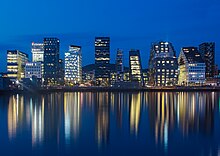Economy of Norway

|
|
| Currency | 1 Norwegian krone (NOK) = 100 øre= 0.12 USD |
|---|---|
| Calendar year | |
|
Trade organisations
|
OECD, WTO, European Economic Area and others |
| Statistics | |
| GDP | $0.4 trillion (Nominal, 2017 est.), $0.4 trillion (PPP, 2017 est.) |
| GDP rank | 23rd (nominal) / 45th (PPP) |
|
GDP growth
|
0.7% (2013 est.) |
|
GDP per capita
|
$71,000 (2017[update] est.) (PPP) (3rd), $74,000 (Nominal, 2017) |
|
GDP by sector
|
agriculture: 2.2%; industry: 45.1%; services: 52.7% (2009 est.) |
| 2.7% (2011 est.) | |
| 0.24 (2014) | |
|
Labour force
|
2.8 million (2015 est.) |
|
Labour force by occupation
|
agriculture: 2.9%; industry: 21.1%; services: 76% (2008) |
| Unemployment | 4.3% (July 2015) |
|
Average gross salary
|
525,000 NOK / € 57,000/ $ 63,000, annual (2016) |
| 386,000 NOK / € 42,000/ $ 46,000, annual (2016) | |
|
Main industries
|
petroleum and natural gas, food processing, shipbuilding, wood pulp and paper products, metals, chemicals, timber, mining, textiles, fishing |
| 6th (2017) | |
| External | |
| Exports | $0.2 trillion (2012 est.) |
|
Export goods
|
petroleum and petroleum products, machinery and equipment, metals, chemicals, ships, fish |
|
Main export partners
|
|
| Imports | $0.1 trillion (2012 est.) |
|
Import goods
|
machinery and equipment, chemicals, metals, foodstuffs |
|
Main import partners
|
(2012 est.) |
|
FDI stock
|
$0.1 trillion (31 December 2009 est.) |
|
Gross external debt
|
$0.5 trillion (30 June 2009) |
| Public finances | |
| 30.3% of GDP (2012 est.) | |
| Revenues | $0.3 trillion (2012 est.) |
| Expenses | $0.2 trillion (2012 est.) |
| Economic aid | $2.2 billion (donor), 0.87% of GDP (2004) [1] |
|
|
|
Foreign reserves
|
$55 billion (March 2011) |
The economy of Norway is a developed mixed economy with state-ownership in strategic areas. Although sensitive to global business cycles, the economy of Norway has shown robust growth since the start of the industrial era. Shipping has long been a support of Norway's export sector, but much of Norway's economic growth has been fueled by an abundance of natural resources, including petroleum exploration and production, hydroelectric power, and fisheries. Agriculture and traditional heavy manufacturing have suffered relative decline compared to services and oil-related industries, and the public sector is among the largest in the world as a percentage of the overall gross domestic product. The country has a very high standard of living compared with other European countries, and a strongly integrated welfare system. Norway's modern manufacturing and welfare system rely on a financial reserve produced by exploitation of natural resources, particularly North Sea oil.
Prior to the industrial revolution, Norway's economy was largely based on agriculture, timber, and fishing. Norwegians typically lived under conditions of considerable scarcity, though famine was rare. Except for certain fertile areas in Hedemarken and Østfold, crops were limited to hardy grains, such as oats, rye, and barley; and livestock to sheep, goats, cattle, pigs, and some poultry; in places this was complemented with hunting. In areas of Central and Northern Norway, the Sami subsisted on the nomadic herding of reindeer. Fishing all around the coast was dangerous work, though fish such as herring, cod, halibut, and other cold-water species were found in abundance. The introduction of the potato to Norway (in the 18th century) provided considerable relief for Norwegians.
All around the coast, the harvesting of fish (including cod, herring, halibut, and other cold water species) was an important supplement to farming and was in many areas in the north and west the primary household subsistence. Fishing was typically supplemented with crop-growing and the raising of livestock on small farms.
...
Wikipedia
